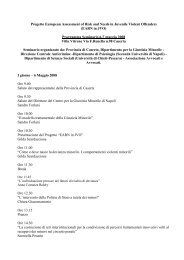Scarica il documento - Dipartimento per la Giustizia Minorile
Scarica il documento - Dipartimento per la Giustizia Minorile
Scarica il documento - Dipartimento per la Giustizia Minorile
Create successful ePaper yourself
Turn your PDF publications into a flip-book with our unique Google optimized e-Paper software.
allegati<br />
psychoanalytic theory and practice distinguish what is specific to the portman:<br />
individual or group treatment based on a psychoanalytic frame for <strong>per</strong>verse, violent or<br />
delinquent patients. training and teaching is offered to psychiatrists specializing in the<br />
forensic field, as well as other professionals who work in hospitals and prisons. ongoing<br />
projects involving consultation, training and treatment have been established for several<br />
years with high security hospitals.<br />
it is the only clinic in the uK and possibly in europe that specializes in this<br />
psychoanalytically-inspired work.<br />
Assessment and Treatment<br />
a certain number of patients are referred to the portman only for assessment. this<br />
can be at the request of the courts, to help the judge decide on an appropriate sentence, or<br />
social services, in order to better p<strong>la</strong>n the future long-term care for a vulnerable individual<br />
who may present a risk; or it may be for medical doctors or psychiatrists wishing to obtain<br />
a more precise diagnosis of the type of <strong>per</strong>version that their patient suffers from, in order<br />
to decide on appropriate treatment.<br />
Forensic psychotherapy, developed at the portman, offers psychoanalytic treatment<br />
to an individual who has committed an offence, is violent, or suffers from a <strong>per</strong>version. the<br />
word “forensic” is used to indicate that the patient has, generally, been involved with the<br />
criminal justice system, and that his actions are prohibited by <strong>la</strong>w. patients are also accepted<br />
who have not committed an offence if they herap the diagnostic criteria of the Clinic.<br />
in the first instance, patients are assessed in a series of six sessions. if the patient<br />
consents, the Gp is asked for information on his medical history: other services might<br />
also provide useful information which can help in the assessment. if the patient has been<br />
referred for treatment, the therapist´s attention w<strong>il</strong>l focus on the patient´s motivation,<br />
his desire and capacity to think psychologically about his behaviour, his history, and his<br />
emotional state of mind.<br />
an essential element to decide if the patient is able to use this type of treatment is to<br />
consider whether he has the capacity to re<strong>la</strong>te to the therapist during the assessment, and<br />
can remember and make links from one session to another. For many patients, this might<br />
be the first time that they have an opportunity to think about themselves in a setting where<br />
they are neither judged nor punished. Because the portman only offers treatment based<br />
on a psychoanalytic model, the assessment has to be thorough, to be able to establish<br />
whether the treatment is appropriate for the patient, and if the patient possesses the<br />
necessary emotional conditions to benefit. a basic condition for treatment to proceed is<br />
that the patient undergoes the treatment voluntar<strong>il</strong>y, not under a court order.<br />
50% of patients who are accepted are offered individual therapy, generally one<br />
session a week. some are seen more often – up to 5 times a week. the other 50% is offered<br />
group treatment – studies show a high <strong>per</strong>centage of satisfactory results. sometimes a<br />
patient is referred to a group only after some years of individual therapy.<br />
Group therapy at the portman is also based on a psychoanalytic model. Groups<br />
are composed of 8 patients maximum. in general there are more men than women, as<br />
many more men are referred than women. exceptionally, este<strong>la</strong> Welldon, the author of<br />
the well-known c<strong>la</strong>ssic work on feminine <strong>per</strong>version, Mother, Madonna, Whore, worked<br />
245





